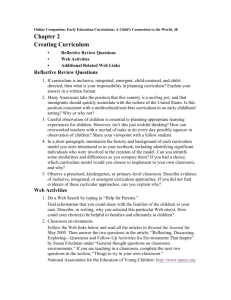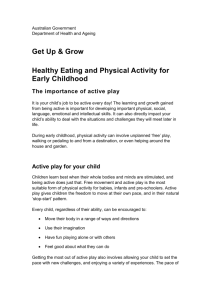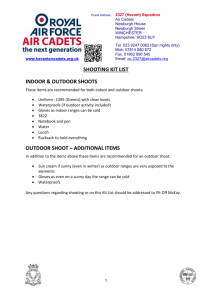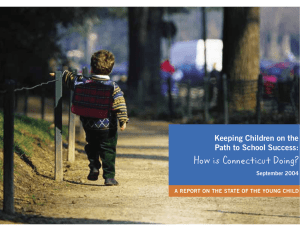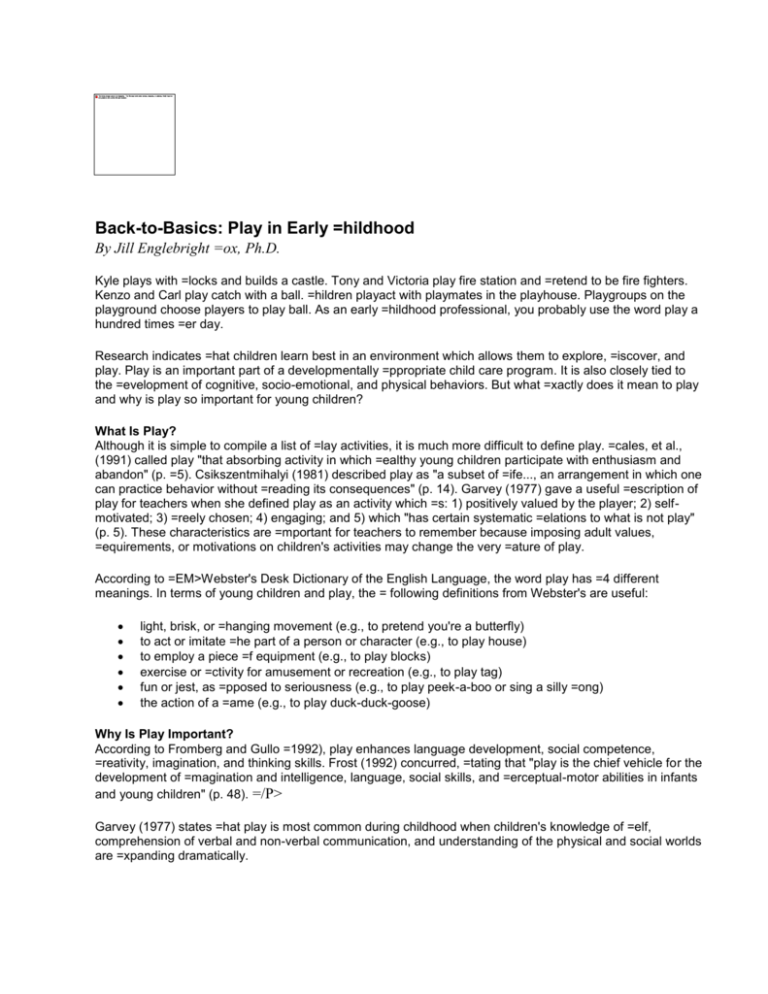
Back-to-Basics: Play in Early =hildhood
By Jill Englebright =ox, Ph.D.
Kyle plays with =locks and builds a castle. Tony and Victoria play fire station and =retend to be fire fighters.
Kenzo and Carl play catch with a ball. =hildren playact with playmates in the playhouse. Playgroups on the
playground choose players to play ball. As an early =hildhood professional, you probably use the word play a
hundred times =er day.
Research indicates =hat children learn best in an environment which allows them to explore, =iscover, and
play. Play is an important part of a developmentally =ppropriate child care program. It is also closely tied to
the =evelopment of cognitive, socio-emotional, and physical behaviors. But what =xactly does it mean to play
and why is play so important for young children?
What Is Play?
Although it is simple to compile a list of =lay activities, it is much more difficult to define play. =cales, et al.,
(1991) called play "that absorbing activity in which =ealthy young children participate with enthusiasm and
abandon" (p. =5). Csikszentmihalyi (1981) described play as "a subset of =ife..., an arrangement in which one
can practice behavior without =reading its consequences" (p. 14). Garvey (1977) gave a useful =escription of
play for teachers when she defined play as an activity which =s: 1) positively valued by the player; 2) selfmotivated; 3) =reely chosen; 4) engaging; and 5) which "has certain systematic =elations to what is not play"
(p. 5). These characteristics are =mportant for teachers to remember because imposing adult values,
=equirements, or motivations on children's activities may change the very =ature of play.
According to =EM>Webster's Desk Dictionary of the English Language, the word play has =4 different
meanings. In terms of young children and play, the = following definitions from Webster's are useful:
light, brisk, or =hanging movement (e.g., to pretend you're a butterfly)
to act or imitate =he part of a person or character (e.g., to play house)
to employ a piece =f equipment (e.g., to play blocks)
exercise or =ctivity for amusement or recreation (e.g., to play tag)
fun or jest, as =pposed to seriousness (e.g., to play peek-a-boo or sing a silly =ong)
the action of a =ame (e.g., to play duck-duck-goose)
Why Is Play Important?
According to Fromberg and Gullo =1992), play enhances language development, social competence,
=reativity, imagination, and thinking skills. Frost (1992) concurred, =tating that "play is the chief vehicle for the
development of =magination and intelligence, language, social skills, and =erceptual-motor abilities in infants
and young children" (p. 48). =/P>
Garvey (1977) states =hat play is most common during childhood when children's knowledge of =elf,
comprehension of verbal and non-verbal communication, and understanding of the physical and social worlds
are =xpanding dramatically.
Fromberg (1990) =laims that play is the "ultimate integrator of human experience" (p. 223). =his means that
when children play, they draw upon their past experiences-things they have done, seen others do, read
=bout, or seen on television-and they use these experiences to build =ames, play scenarios, and engage in
activities.
Children use fine =nd gross motor skills in their play. They react to each other =ocially. They think about what
they are doing or going to do. They use =anguage to talk to each other or to themselves and they very often
=espond emotionally to the play activity. The integration of these =ifferent types of behaviors is key to the
cognitive development of =oung children. According to Rogers and Sawyer (1988), "until at =east the age of
nine, children's cognitive structures function best =n this unified mode" (p. 58). Because children's play draws
upon =ll of these behaviors, it is a very effective vehicle for =earning.
Play and =ognitive Development
The relationship between play and =ognitive development is described differently in the two theories of
cognitive development which dominate early childhood education-Piaget's and Vygotsky's.
Piaget (1962) =efined play as assimilation, or the child's efforts to make environmental =timuli match his or
her own concepts. Piagetian theory holds that =lay, in and of itself, does not necessarily result in the
formation =f new cognitive structures. Piaget claimed that play was just for pleasure, and while it allowed
children to practice things =hey had previously learned, it did not necessarily result in the =earning of new
things. In other words, play reflects what the child has =lready learned but does necessarily teach the child
anything new. =n this view, play is seen as a "process reflective of emerging =ymbolic development, but
contributing little to it" (Johnsen & =hristie, 1986, p. 51).
In contrast, =ygotskian theory states that play actually facilitates cognitive development. = Children not only
practice what they already know-they also =earn new things. In discussing Vygotsky's theory, Vandenberg
=1986) remarks that "play not so much reflects thought (as Piaget =uggests) as it creates thought" (p. 21).
Observations of =hildren at play yield examples to support both Piagetian and Vygotskian =heories of play. A
child who puts on a raincoat and a firefighter's hat =nd rushes to rescue his teddy bear from the pretend
flames in =is play house is practicing what he has previously learned about =ire fighters. This supports
Piaget's theory. On the other hand, = child in the block center who announces to his teacher, "Look! =hen I
put these two square blocks together, I get a rectangle!" has constructed new knowledge through her play.
This supports =ygotsky's theory. Whether children are practicing what they have =earned in other settings or
are constructing new knowledge, it is =lear that play has a valuable role in the early childhood =lassroom.
Play-Indoors =nd Out
Early childhood teachers have long =ecognized the value of play in programs for young children.
Unfortunately, = teachers often fail to take advantage of the opportunities =lay provides for observing
children's development and learning. =hrough such observations teachers can learn about children's social =
interactions, cognitive and language abilities, motor =kills, and emotional development.
Frost (1992) =ecommends that observing children at play be a daily responsibility for =arly childhood
professionals. Regular observations provide =eachers with assessment information for identifying children
with special =eeds, planning future play experiences, evaluating play materials, = determining areas of
strength and weakness for individual =hildren, planning curriculum for individual children, reporting to =arents,
and checking on a child's on-going progress. The increased =se of authentic assessment strategies is making
observations of =hildren's play more commonplace in early childhood classrooms. =/P>
Hymes (1981) =ecommends that children have two classrooms—one indoors and one =utdoors. The outdoor
play environment should be used as an extension of =he indoor classroom. It should be a learning
environment as =arefully planned as the indoor activity centers and should encourage =otor and social skills
as well as help children refine existing =ognitive structures and construct new ones. Used in this way, the
=utdoor play environment provides a basis for observational =ssessments in all areas of development.
Fox (1993) =esearched the practicality of observing young children's cognitive =evelopment during outdoor
play. Her observations of four- and =ive-year-old children during outdoor play found examples of addition and
subtraction, shape identification, patterning, one-to-one correspondence, number sense, sequencing of
events, use of =rdinal numbers, knowledge of prepositions, and identification of =inal and initial consonants.
Fox's outdoor observations also found =ultiple examples of problem-solving, creative thinking, social
=ompetence, language use, and gross and fine motor skills. Although =utdoor observations do not replace
classroom assessment, they can =rovide valuable information for teachers of young children. As Fox =tated,
"These observations can be performed unobtrusively, without intruding upon the children's activities and
without placing = children in a stressful testing situation" (p. 131).
Parten's Five =ypes of Play
Play for =oung children assumes many different forms. Mildred Parten (1932) =as one of the early
researchers studying children at play. She =ocused on the social interactions between children during play
=ctivities. Parten's categories of play are not hierarchical. Depending =n the circumstances, children may
engage in any of the different =ypes of play. Parten does note, however, that in her research with =wo- to
five-year-olds, "participation in the most social types of =roups occurs most frequently among the older
children" (p. 259).
Onlooker behavior—Playing =assively by watching or conversing with other children engaged in
play = activities.
Solitary independent—Playing by oneself.
Parallel—Playing, =ven in the middle of a group, while remaining engrossed in one's own activity.
Children playing parallel to each other =ometimes use each other's toys, but always maintain their
independence.
Associative—When =hildren share materials and talk to each other, but do not coordinate =lay
objectives or interests.
Cooperative—When =hildren organize themselves into roles with specific goals in mind (e.g., =o
assign the roles of doctor, nurse, and patient and play =ospital).
How Much =hould Children Play?
Indoors and =utdoors, children need large blocks of time for play. According to =hristie and Wardle (1992),
short play periods may require children =o abandon their group dramatizations or constructive play just =hen
they begin to get involved. When this happens a number of =imes, children may give up on more
sophisticated forms of play and =ettle for less advanced forms that can be completed in short =eriods of time.
Shorter play periods reduce both the amount and the =aturity of children's play, and many important benefits
of play, =uch as persistence, negotiation, problem-solving, planning, and =ooperation are lost. Large blocks of
time (30 to 60 minutes, or longer) =hould be scheduled for indoor and outdoor play periods. Christie =nd
Wardle remind teachers that extra play time does not result =n children becoming bored. Instead, it prompts
children to =ecome involved in more complex, more productive play activities.
The Teacher's Role
The early =hildhood teacher is the facilitator of play in the classroom. The =eacher facilitates play
by providing appropriate indoor and outdoor =lay environments. Safety is, of course, the primary
concern. Age =nd developmental levels must be carefully considered in the =esign and selection of
materials. Guidelines for selecting safe and appropriate equipment for outdoor play environments are
=vailable through the U.S. Consumer Product Safety Commission's =andbook for Public Playground
Safety and the Playground Safety =anual by Jambor and Palmer (1991). Similar guidelines are also
=vailable for indoor settings (Torelli & Durrett, 1996; Caples, =996; Ard & Pitts, 1990). Once
appropriate environments and =aterials are in place, regular safety checks and maintenance are
needed =o ensure that the equipment is sound and safe for continued play.
Teachers also =acilitate play by working with children to develop rules for safe indoor and =utdoor play.
Discussion about the appropriate use of materials, the =afe number of participants on each piece of
equipment, taking =urns, sharing, and cleaning up provides the children with =nformation to begin their play
activities. These discussions need to be =ngoing because some children may need frequent reminders about
=ules and because new situations may arise (e.g., new =quipment).
By providing play =aterials related to thematic instruction, early childhood teachers =an establish links
between the children's indoor and outdoor =lay and their program's curriculum. Thematic props for dramatic
play =an be placed in the dramatic play center or stored in prop boxes =nd taken outside to extend the
dramatic play to a new setting. An art =enter in the outdoor play environment may encourage children to
=xplore the possibilities of using leaves, twigs, pebbles, and sand =n their three-dimensional art productions.
Painting easels and water =ables may also be moved outside periodically for children's use =uring outdoor
play periods. Finally, a collection of books stored =n a wagon to be taken outside during play time may offer
some =hildren a needed alternative to more active play.
As facilitators of =hildren's play, teachers should closely observe children during play =eriods not only for
assessment purposes, as stated earlier, but =lso to facilitate appropriate social interactions and motor
=ehaviors. It is important that children be the decision-makers during =lay, choosing what and where to play,
choosing roles for each =layer, and choosing how play will proceed. Occasionally, however, some =hildren
will need adult assistance in joining a play group, =odifying behavior, or negotiating a disagreement. Careful
observation =ill help the teacher to decide when to offer assistance and what =orm that assistance should
take.
Conclusion
Although play is a =ifficult concept to define, it is very easy to recognize. Children =ctively involved in play
may be engaged in a variety of activities, independently, with a partner, or in a group. Because play =s
closely tied to the cognitive, socio-emotional, and motor development of young children, it is an important part
of developmentally appropriate early childhood programs. =/P>
Jill =nglebright Fox, Ph.D., is an assistant professor of early childhood = education at Virginia
Commonwealth University. She taught kindergarten and first grade in the Texas public schools for =ight
years, and is currently an active member of the =nternational Play Association-USA. Her research interests
focus on play and =esthetic development in young children, and professional development schools.
References
Ard, L. & Pitts, =. (Eds.). (1990). Room to grow: How to create quality =arly childhood environments. Austin,
TX: Texas Association =or the Education of Young Children.
Caples, S.E. (1996). =ome guidelines for preschool design. Young Children, 51 =4), 14-21.
Christie, J.F. & =ardle, F. (1992). How much time is needed for play? Young =hildren, 47 (93), 28-32.
Csikszentmihalyi, M. =1981). Some paradoxes in the definition of play. In Cheska, A.T. =Ed.). Play as
context, (pp. 14-26). West Point, NY: =eisure Press.
Fox, J.E. (1993). =ssessing cognitive development by observing children's outdoor play. =n M. Guddemi & T.
Jambor, (Eds.). A right to play: =roceedings of the American Affiliate of the International Association for =he
Child's Right to Play, September 17-20, 1992, Denton, =exas, (pp. 128-131). Little Rock, AK: Southern Early
Childhood Association.
Fromberg, D.P. & =ullo, D.F. (1992). Perspectives on children. In L.R. Williams & =.P. Fromberg (Eds.),
Encyclopedia of early childhood =ducation, (pp. 191-194). New York: Garland Publishing, Inc. =/P>
Fromberg, D.P. =1990). Play issues in early childhood education. In Seedfeldt, C. (Ed.), = Continuing issues
in early childhood education, =pp. 223-243). Columbus, OH: Merrill.
Frost, J.L. (1992). =EM>Play and playscapes. Albany, NY: Delmar. G
arvey, C. (1977). =EM>Play. Cambridge, MA: Harvard University Press.
Hymes, J.L. =1981).Teaching the child under six (3rd. ed.). Columbus, OH: =errill.
Jambor, T. & =almer, S.D. (1991). Playground safety manual. Birmingham, AL: =he Alabama Chapter of
American Academy of Pediatrics. =/P>
Johnsen, E.P. & =hristie, J.F. (1986). Pretend play and logical operations. In K. =lanchard (Ed.). The many
faces of play (pp. 50-58). =hampaign, IL: Human Kinetics.
Parten, M. (1932). =ocial participation among preschool children. Journal of =bnormal and Social Psychology,
27, 243-269.
Piaget, J. (1962). =EM>Play, dreams, and imitation in childhood. New York: W.W. =orton & Co.
Rogers, C. & =awyers, J. (1988). Play in the lives of children. Washington, =C: NAEYC.
Scales, B.; Almy, =.; Nicolopulou, A.; & Ervin-Tripp, S. (1991). Defending =lay in the lives of children. In B.
Scales ; M. Almy ; A. Nicolopulou ; =amp; S. Ervin-Tripp (Eds.). Play and the social context of development in
early care and education, (pp. 15-31). =ew York: Teachers' College, Columbia University.
Smilansky, S. =1968). The effects of sociodramatic play on disadvantaged preschool children. New York:
John Wiley & Sons.
Torelli, L. & =urrett, C. (1996). Landscape for learning: The impact of classroom =esign on infants and
toddlers. Earlychildhood NEWS, 8 (2), 12-17.
U.S. Consumer =roduct Safety Commission. (1991). A handbook for public playground safety. Washington,
DC: U.S. Government Printing =ffice.
Vandenberg, B. =1986). Play theory. In G. Fein & M. Rivkin, (Eds.), The young =hild at play, (pp. 17-22).
Washington, DC: =AEYC.
© 2007 Excelligence Learning Corporation, =ll Rights Reserved.


